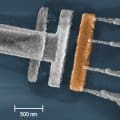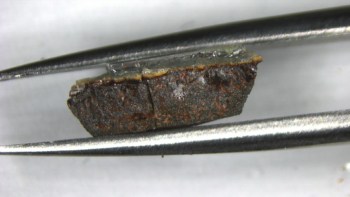Physicists in Finland and Italy have unveiled plans for a tiny refrigerator that might be able to cool objects to temperatures as low as 10 mK. The device, which has been partially built, works by allowing single "hot" electrons to tunnel through an insulating gap from a metal island to a superconducting lead. According to Jukka Pekola of the Helsinki University of Technology, the device has the potential to be about three times more efficient than conventional tunnel-junction refrigerators, which struggle to cool below about 100 mK (Phys. Rev. Lett. 98 037201).

While physicists have exploited the thermal properties of magnetic nuclei to reach temperatures as low as 100 pK, these techniques are not suitable for cooling relatively large structures such as an electronic sensor. Instead, researchers are looking at the tunnel-junction refrigerator as a practical way to cool devices such as space-based photon detectors used by astronomers.
These refrigerators work by having hot electrons (those with energies above the Fermi level) tunnel out of a piece of metal and into a superconductor, thereby removing heat from the metal. The tunnelling of electrons through an insulating material is a quantum process that is encouraged by applying a fixed voltage between the metal and superconductor. However, it is not always the hottest electrons that leave the metal and this limits the cooling efficiency of conventional tunnel-junction refrigerators.
The new single-electron refrigerator improves on this process by using a tunnel junction through which only one electron can squeeze through at a time. This is called a “coulomb blockade” junction in which mutual repulsion between electrons prevents multiple tunnelling. This orderly tunnelling process ensures that only the hottest electrons can leave the metal, thereby boosting the cooling efficiency. The researchers also replaced the conventional fixed voltage with an oscillating radio-frequency signal that could be synchronized with the tunnelling events. The oscillatory nature of the RF signal meant that “cold” electrons also tunnelled into the metal from the superconductor, further enhancing the cooling process.
Pekola told Physics Web that the design is the first cyclic refrigerator that is based on electron transport. His team has already built prototype devices, which they have characterized using fixed voltages (see figure “Single-electron refrigerator”). The prototype has a metal island that is about 1 µm high and 100 nm wide. “We are now planning to try the devices using RF signals”, said Pekola.
While the single-electron refrigerator has the potential to out-cool existing tunnel-junction devices, Pekola does not believe that it will find practical application outside of basic research. This is because conventional tunnel-junction refrigerators offer greater heat lift (the ability to remove heat from an object) and should be sufficient to cool cryogenic sensors. However, he believes that the refrigerator could be used to study the behaviour of electrons at lower temperatures than before. This could allow physicists to study mesoscopic phenomena and superconductivity in nanometre-scale structures.



